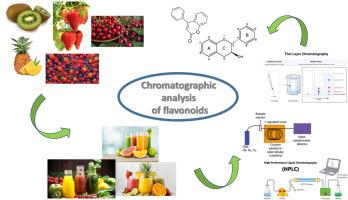水果中黄酮类化合物色谱分析综述
IF 3.2
引用次数: 0
摘要
类黄酮是水果中丰富的天然化合物,对人体健康有很多好处。它们的抗氧化、抗炎和抗癌作用使这些化合物对健康很重要。色谱分析方法是检测、分离和定量水果中黄酮类化合物最常用的方法。高效液相色谱法(HPLC)、气相色谱法(GC)、薄层色谱法(TLC)和液相色谱-串联质谱法(LC-MS)是分析黄酮类化合物的重要方法。近年来,结合质谱和紫外(UV)检测器的混合系统被开发出来,以提高这些技术的灵敏度。HPLC-MS技术是测定黄酮类化合物最常用的方法之一。利用该技术比较了不同水果品种间的类黄酮谱。虽然气相色谱法应用较少,但它使用衍生化步骤来分析非挥发性黄酮类化合物。与其他方法相比,气相色谱的准确度和灵敏度可能受到限制。薄层色谱法是一种更简单、更经济的分离黄酮类化合物的方法。然而,由于其定量分析能力有限,其应用不如HPLC广泛。近年来,色谱分析方法在技术上有了很大的发展。超高效液相色谱法(UHPLC)具有分析时间短、分辨率高的特点,尤其适用于复杂类黄酮混合物的分离。本文综述了用色谱法分析水果中黄酮类化合物的研究进展,并对国内外有关测定水果中黄酮类化合物的研究进行了综述。本文章由计算机程序翻译,如有差异,请以英文原文为准。

Comprehensive review on chromatographic analysis of flavonoids in fruits
Flavonoids are natural compounds that are abundant in fruits and have many benefits for human health. Their antioxidant, anti-inflammatory, and anticancer effects make these compounds important for health. Chromatographic analytical methods are the most commonly used methods for detecting, separating, and quantifying flavonoids in fruit species. Methods such as high-performance liquid chromatography (HPLC), gas chromatography (GC), thin-layer chromatography (TLC), and liquid chromatography-tandem mass spectrometry (LC-MS) are crucial for the analysis of flavonoids. In recent years, hybrid systems combining MS and ultraviolet (UV) detectors have been developed to increase the sensitivity of these techniques. HPLC-MS techniques are one of the most preferred methods for determining flavonoids. Flavonoid profiles between different fruit species have been compared using this technique. Although the GC method is less widely used, it uses derivatization steps to analyze non-volatile flavonoids. The accuracy and sensitivity of GC may be limited compared to other methods. TLC, a simpler and more economical method, is still preferred for separating flavonoids. However, it is less widely used than HPLC due to its limited quantitative analysis capacity. Recently, there have been technological developments in chromatographic methods of analysis. Ultra-high-performance liquid chromatography (UHPLC) offers shorter analysis times and higher resolution, especially for separating complex flavonoid mixtures. In this review, the analysis of flavonoids using chromatographic methods and a detailed discussion of studies in the literature to determine flavonoids in fruits are discussed.
求助全文
通过发布文献求助,成功后即可免费获取论文全文。
去求助
来源期刊

Journal of chromatography open
Analytical Chemistry
CiteScore
2.50
自引率
0.00%
发文量
0
审稿时长
50 days
 求助内容:
求助内容: 应助结果提醒方式:
应助结果提醒方式:


